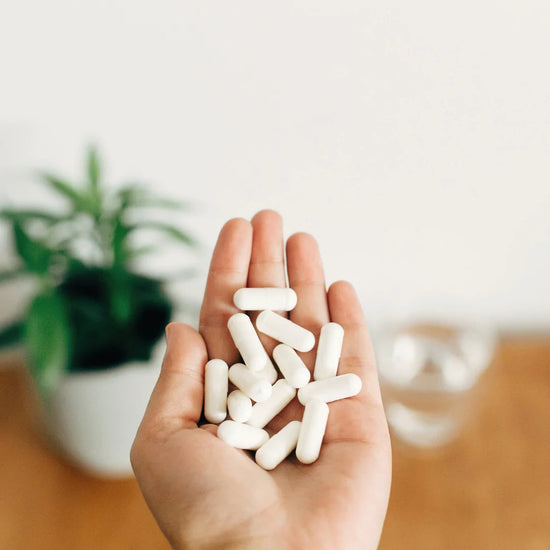Beyond Antibiotics: Understanding the Truth About UTIs and Candida Yeast Infections
Urinary tract infections (UTIs) are the second most common type of infectious disease (1). Most of the time, UTIs are thought of as infections caused by bacterial contamination. After all, the urethra is an opening that is very close in proximity to the anal opening. Therefore, some of the natural bacterial inhabitants of the large intestines can cause significant problems upon getting access to the urinary tract and the urethra. (2)
Blog Contents
Hidden Cost of Treating a UTI with Antibiotics
Though it is correct that the intestinal E.coli bacteria causes many UTIs, there is a much less commonly regarded source of UTIs. Fungal UTIs are the most frequent nosocomial fungal infection (a healthcare-associated infection) worldwide. Treating a UTI with antibiotics is a primary treatment, and because of this – the most common fungal agent that causes UTIs, Candida albicans, appears to have evolved new antifungal resistance mechanisms. (1, 3)
Candida Albicans Is Not Evil
We often think of our healthy flora as our helpful bacterial inhabitants. In reality, our human flora consists of many other microorganisms, including fungi and yeasts. For example, Candida albicans is an essential part of the microbial flora of the mouth, vagina and digestive tract. Some evidence even points to the urinary tract colonization of premenopausal healthy women with candida. Most of the time, candida does not seem to cause any severe issues to the body areas that it colonizes. In fact, it is shown to be a healthy symbiotic partner. However, problems start when the microbial balance is disrupted with an agent that clears one type of microorganism and allows the rest to flourish. ( 2,4)
Who Is At Risk of Candidal UTIs?
Candida is one of the most successful microorganisms at adhering to surfaces. Their adhesion capacity is an essential part of their success at living symbiotically inside of the body. Unfortunately, the capacity to adhere to cells turns into solid grounds to support candidal infections. (6)
The other factor that helps candida be more pathogenic is its ability to form biofilms. A biofilm is a colony of candida that collaborates to live together and functions as a semi-unit. When such a unit is built, it becomes complicated for the immune system and any medications to reach deep enough into the colony to break it down and end the infection (7, 8). The following people have the highest risk of getting a candidal UTI:
Older individuals
Women
Antibiotic users
Sexually active individuals
Immune compromised individuals
Hospitalized patients
Kidney stone sufferers
Users of catheters or prostheses
Those suffering malnutrition
Those with inadequate individual hygiene (5)
The Importance of Probiotics
Probiotics are the body’s first line of defence outside of the human immune system. Those tiny symbiotic bacteria that live on our bodies can maintain our health by producing chemicals that talk to our immune system (9). Additionally, they can keep us safe as they compete with other, more pathogenic bacteria. Unfortunately, overuse of antibiotics highly disrupts the microbial balance of the body. While antibiotics can be life-saving, when heavily prescribed, they can lead to other issues like the issue of candidal UTIs and an overall increase in candida colonies, especially for women. When the microbial balance is disrupted, it is imperative to reintroduce probiotics to ensure that the body can rebalance its symbiotic relationships. (10, 11)
Women often think that their UTIs are recurring or that their previous UTI has not cleared when they experience vaginal/ urinary symptoms after using antibiotics for a UTI. Unfortunately, the issue can be much more profound as removing some bacterial colonies can lead to an overpopulation of yeast in the vagina or even a fungal UTI. (12)
Science-Backed Alternatives to Treating a UTI with Antibiotics
Cranberries are suitable for healing the urinary system, but their use appears not to be reliable. While science shows excellent benefits from the astringent effect of cranberries, and their capacity to reduce the microbial load in the urinary system, cranberry use is limited by the amount of sugar any preparation contains (13). While many assume that taking a little bit of cranberry juice may help them recover, high-sugar cranberry juices may not be very effective. Most bacteria flourish on sugar consumption. Additionally, most juices are not concentrated enough to contain active constituents. A high-quality, medicinal preparation of cranberry is one that is free of sugar and is concentrated enough to have an active amount of therapeutic components. (14)
Sorrel Hibiscus is enjoyed as a refreshing drink all over the world. Their therapeutic value is well regarded in terms of blood pressure control. However, their capacity to prevent and clear a broad range of UTIs is rarely discussed (15). While hibiscus is shown to be antimicrobial, it appears to be much more of an overall agent of balanced urinary health than simply an antimicrobial agent. Hibiscus is shown to have the following benefits:
Inhibits Candida adhesion
Inhibits Candida biofilm formation
Is shown to decrease the rate of microbial growth
Decreases microbial load
Is a reliable diuretic (16)
Serrapeptase
It is often crucial to consider biofilm formation when it comes to fungal urinary tract infections. As previously outlined, candida is very good at sticking to cells, so it is complicated for any antimicrobial agent to make its way deep into a colony and clear it. Thus, it is always best to make sure that we introduce any form of therapy with an agent that helps the treatment penetrate deep into the colony. (17)
Serrapeptase is a proteolytic enzyme that breaks down inflammatory markers and has many applications for pain and general health. Studies show that serrapeptase is effective at breaking down biofilms. As a well-tolerated agent, serrapeptase can be used therapeutically with antimicrobials, antibiotics and anti-adhesion agents to increase the speed of microbial clearance and make the therapy more effective overall. (18)
One fantastic bonus offered by serrapeptase is its capacity to reduce inflammation. The inflammatory discomfort that can e felt during a UTI can be significantly relieved with the application of serrapeptase. Additionally, as the inflammatory load decreases, it becomes easier for the body to heal tissues. (19)
Importance of water for a UTI
UTIs are more prevalent and severe for individuals who do not drink enough water. Adequate water intake flushes the urinary tract and gives the body the chance to get rid of high microbial loads. Water also prevents irritation to the urinary tract and reduces the inflammatory load. All urinary treatments work better with the intake of adequate to high amounts of water; thus, it is essential for anyone suffering from a UTI to increase water intake to a maximum!
Article References
Valiquette L. Urinary tract infections in women. The Canadian journal of urology. 2001 Jun 1;8:6-12.
Foxman B. The epidemiology of urinary tract infection. Nature Reviews Urology. 2010 Dec;7(12):653-60.
Behzadi P, Behzadi E, Ranjbar R. Urinary tract infections and Candida albicans. Central European journal of urology. 2015;68(1):96.
Ohshima T, Kojima Y, Seneviratne CJ, Maeda N. Therapeutic application of synbiotics, a fusion of probiotics and prebiotics, and biogenics as a new concept for oral Candida infections: a mini review. Frontiers in Microbiology. 2016 Jan 25;7:10.
Krcmery S, Dubrava M, Krcmery Jr V. Fungal urinary tract infections in patients at risk. International journal of antimicrobial agents. 1999 May 1;11(3-4):289-91.
Sundstrom P. Adhesion in Candida spp. Cellular microbiology. 2002 Aug;4(8):461-9.
Fukazawa Y, Kagaya K. Molecular bases of adhesion of Candida albicans. Journal of Medical and Veterinary Mycology. 1997 Jan 1;35(2):87-99.
Ramage G, Saville SP, Thomas DP, Lopez-Ribot JL. Candida biofilms: an update. Eukaryotic cell. 2005 Apr;4(4):633-8.
West NP, Pyne DB, Peake JM, Cripps AW. Probiotics, immunity and exercise: a review. Exerc Immunol Rev. 2009 Jan 1;15(107):e26.
Sartor RB. Therapeutic manipulation of the enteric microflora in inflammatory bowel diseases: antibiotics, probiotics, and prebiotics. Gastroenterology. 2004 May 1;126(6):1620-33.
Kurowski K, Ghosh R, Singh SK, Beaman KD. Clarithromycin-induced alterations in vaginal flora. American Journal of Therapeutics. 2000 Sep 1;7(5):291-5.
Spinillo A, Capuzzo E, Acciano S, De Santolo A, Zara F. Effect of antibiotic use on the prevalence of symptomatic vulvovaginal candidiasis. American journal of obstetrics and gynecology. 1999 Jan 1;180(1):14-7.
Guay DR. Cranberry and urinary tract infections. Drugs. 2009 May;69(7):775-807.
Bailey DT, Dalton C, Daugherty FJ, Tempesta MS. Can a concentrated cranberry extract prevent recurrent urinary tract infections in women? A pilot study. Phytomedicine. 2007 Apr 10;14(4):237-41.
Chou ST, Lo HY, Li CC, Cheng LC, Chou PC, Lee YC, Ho TY, Hsiang CY. Exploring the effect and mechanism of Hibiscus sabdariffa on urinary tract infection and experimental renal inflammation. Journal of ethnopharmacology. 2016 Dec 24;194:617-25.
Alshami I, Alharbi AE. Hibiscus sabdariffa extract inhibits in vitro biofilm formation capacity of Candida albicans isolated from recurrent urinary tract infections. Asian Pacific journal of tropical biomedicine. 2014 Feb 1;4(2):104-8.
Hogan S, Zapotoczna M, Stevens NT, Humphreys H, O'Gara JP, O'Neill E. Potential use of targeted enzymatic agents in the treatment of Staphylococcus aureus biofilm-related infections. Journal of Hospital Infection. 2017 Jun 1;96(2):177-82.
Donlan RM. Role of biofilms in antimicrobial resistance. ASAIO journal. 2000 Nov 1;46(6):S47-52.
Nasser A, Soltan Dallal MM, Jahanbakhshi S, Azimi T, Nikouei L. Staphylococcus aureus: biofilm formation and strategies against it. Current pharmaceutical biotechnology. 2021









Leave a comment